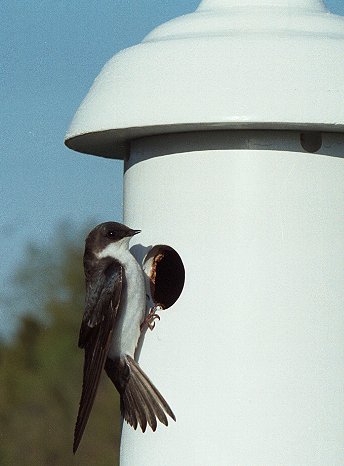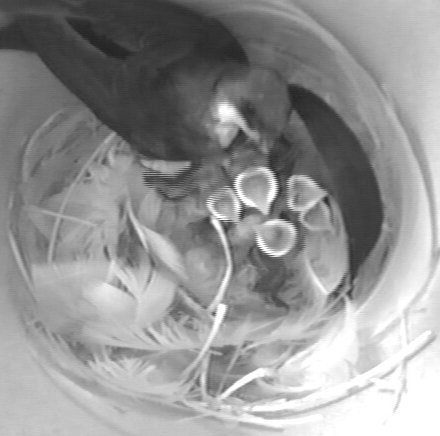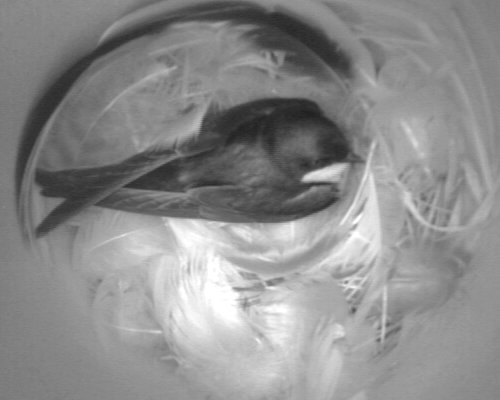

 This nestbox in our side yard is fitted with a video camera running around the clock. An alternative to the lathe turned coopered wood nestboxes I have been making, this one has the same heavy lathe turned lid on an insulated pvc cylinder. The b&w video camera with infrared illumination allows 24 hour viewing, even in total darkness. The white feathers in tree swallow nests cause something of a problem for the camera's automatic exposure when an adult swallow is not present
This nestbox in our side yard is fitted with a video camera running around the clock. An alternative to the lathe turned coopered wood nestboxes I have been making, this one has the same heavy lathe turned lid on an insulated pvc cylinder. The b&w video camera with infrared illumination allows 24 hour viewing, even in total darkness. The white feathers in tree swallow nests cause something of a problem for the camera's automatic exposure when an adult swallow is not present
The following still photos are taken from a single frame of video from the vhs tapes. This process results in a substantial loss of quality compared to the original camera image and vhs tape.
 6/21/2001 update: Of the three simultaneous tree swallow nestings in our yard this spring, this one faired the worst. The front yard tree swallows fledged 5 of 5 without event, while the barnyard tree swallows fledged 4 of 4 eggs. This nesting fledged only 3 of 5 eggs. Weather and difficult hunting didn't seem to play a role, since the other tree swallow and bluebird nests as well as the nests of numerous open nesting species did fine. This particular pair of tree swallows delayed egg laying long after their nest was completed. They also were very poor incubators, compared to the front yard pair. But after the eggs hatched they seemed to do a fine job of bringing food, at least in terms of frequency. One nestling died on 6/1 and a second on 6/5. The nest material was changed at that time and was not infested with blowflies. The surviving young all appeared to be healthy and vigorous. It may be just a case of the fittest nestlings gaining the attention of the adults with their calls and thus getting all the food. In cavity nesters, this is especially true when the nestlings are old enough to jump up to the entrance hole to be fed. If food is scarce or foraging conditions are poor, the older and stronger nestlings remain hungry and the smaller late hatcher may never make it to the entrance.
6/21/2001 update: Of the three simultaneous tree swallow nestings in our yard this spring, this one faired the worst. The front yard tree swallows fledged 5 of 5 without event, while the barnyard tree swallows fledged 4 of 4 eggs. This nesting fledged only 3 of 5 eggs. Weather and difficult hunting didn't seem to play a role, since the other tree swallow and bluebird nests as well as the nests of numerous open nesting species did fine. This particular pair of tree swallows delayed egg laying long after their nest was completed. They also were very poor incubators, compared to the front yard pair. But after the eggs hatched they seemed to do a fine job of bringing food, at least in terms of frequency. One nestling died on 6/1 and a second on 6/5. The nest material was changed at that time and was not infested with blowflies. The surviving young all appeared to be healthy and vigorous. It may be just a case of the fittest nestlings gaining the attention of the adults with their calls and thus getting all the food. In cavity nesters, this is especially true when the nestlings are old enough to jump up to the entrance hole to be fed. If food is scarce or foraging conditions are poor, the older and stronger nestlings remain hungry and the smaller late hatcher may never make it to the entrance.
While the camera remained on continuously, I only taped short periods of time each day. However, the tree swallow behavior within the nest box was fascinating enough to warrant 24 hour taping throughout the nesting next year. One surprise was a prolonged copulation inside the nestbox, with the adults flapping about on top of the nestlings. This was likely another male since extra-pair copulations are frequent among nesting tree swallows. The adults seldom entered the box at the same time. They would go off together to hunt and return together, but one would wait on top of the box while the other fed a nestling. When the first adult left the box, the other would enter and feed another nestling. Then both would go off together again. The front yard bluebirds did the same. Luckily these species have little need to guard their nests in our yard. They probably realized this, and if a house sparrow or wren were interested in the nestbox, they would likely have not gone off together so often. With so many bluebirds and tree swallows around, males of both species may have been more interested in guarding their mates from other males than in worrying about predators.
The last image on 6/16 shows the last two nestlings fledging. The first had fledged the day before. Actually the second nestling had remained perched in the entrance for a very long time. The third nestling, on the bottom of the nest, seemed to finally lose patience with its sibling blocking the hole and flew up, pushing the other bird out the hole and also launching itself. Such video will be quite enjoyable to view next winter, sitting by the fire, while the tree swallows are in Central America.
 June 2002 update The cameras were tied up with flickers, kestrels, chickadees and wrens this spring, so I didn't tape the three tree swallow pairs. Two pair had second broods this year. I know the older books claim one brood, but ever since they arrived here in Maryland, one or more of ours have had a second brood each year. One pair began to nest in the recently vacated bluebird box in the back garden when we went away for 3 days. When we returned, we found a dead tree swallow on a new nest cup in the box. A male house sparrow had been spotted on the martin supergourds the day before we left, so the gourds were all closed while we were away. Likely the sparrow killed the swallow. He had no interest in the nests when we returned and had set up a female in a nest under the barn eaves. The nest was destroyed and the male was shot at the corn feeder (provided for that purpose). Interestingly, in 2 days the lone male tree swallow was nesting in another box with a juvenile female. We have always had some juvenile (gray) females helping at nests but this is the first one I had ever noticed breeding. They fledged 4 young with no problems and the bluebirds used the other box for a second brood. Now, they are beginning a third brood in that box. This is another case where running videotape in an empty nestbox can be useful. The "between nesting" time can be as interesting as the nestling phase.
June 2002 update The cameras were tied up with flickers, kestrels, chickadees and wrens this spring, so I didn't tape the three tree swallow pairs. Two pair had second broods this year. I know the older books claim one brood, but ever since they arrived here in Maryland, one or more of ours have had a second brood each year. One pair began to nest in the recently vacated bluebird box in the back garden when we went away for 3 days. When we returned, we found a dead tree swallow on a new nest cup in the box. A male house sparrow had been spotted on the martin supergourds the day before we left, so the gourds were all closed while we were away. Likely the sparrow killed the swallow. He had no interest in the nests when we returned and had set up a female in a nest under the barn eaves. The nest was destroyed and the male was shot at the corn feeder (provided for that purpose). Interestingly, in 2 days the lone male tree swallow was nesting in another box with a juvenile female. We have always had some juvenile (gray) females helping at nests but this is the first one I had ever noticed breeding. They fledged 4 young with no problems and the bluebirds used the other box for a second brood. Now, they are beginning a third brood in that box. This is another case where running videotape in an empty nestbox can be useful. The "between nesting" time can be as interesting as the nestling phase.
 Dec 2004 update This year tree swallows used a new slant box intended for bluebirds. The purpose of the slant box is to allow a more interesting angle of view than the typical top down view of other boxes. Despite the presence of the usual white chicken feathers, there was a good view of the nestlings in the slant box. I had expected that the feathers would obscure the view if tree swallows used the box instead of bluebirds.
Dec 2004 update This year tree swallows used a new slant box intended for bluebirds. The purpose of the slant box is to allow a more interesting angle of view than the typical top down view of other boxes. Despite the presence of the usual white chicken feathers, there was a good view of the nestlings in the slant box. I had expected that the feathers would obscure the view if tree swallows used the box instead of bluebirds.
tree swallow nestlings in the slant box
tree swallow nestlings in the slant box
tree swallow nestlings in the slant box
tree swallow nestlings in the slant box
2005 update The slant box was used by tree swallows again this year, with two broods fledging from it. Actually, three of our tree swallow boxes had two broods. Since there were plenty of empty boxes nearby, it seems even more likely that our tree swallows are sometimes having double broods. I didn't videotape any of their nestings, since the video equipment was tied up with bats, purple martins, flickers, brown thrashers, and sand wasps.
| barn owl | American kestrel | purple martin | barn swallow | Eastern bluebird |
| tufted titmouse | Eastern phoebe | yellow shafted flicker | tree swallow | chimney swift |
| house wren | big brown bat | Carolina wren | brown thrasher | catbird |
| cedar waxwing | Northern mockingbird | |||
| Yellow warbler | Acadian flycatcher | |||
email richard@americanartifacts.com
© 2001 - 2010, American Artifacts and Richard Van Vleck, Taneytown, Maryland.